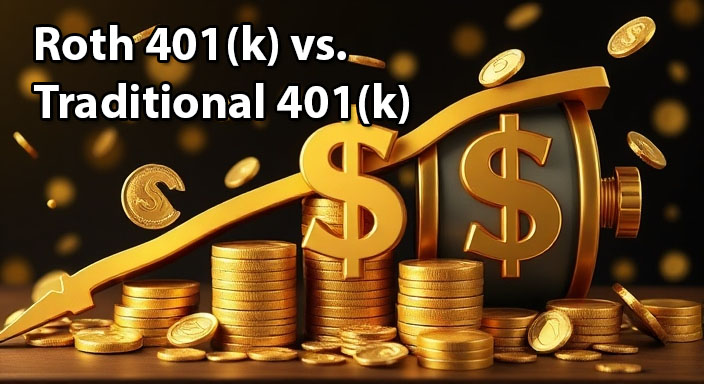
When planning for retirement, choosing the right savings vehicle is essential for maximizing your future income. The Roth 401(k) and Traditional 401(k) are two popular options, each with unique benefits. Understanding how these accounts differ in tax treatment, contributions, and withdrawals will help you decide which one aligns best with your retirement goals.
What is a Traditional 401(k)?
A Traditional 401(k) is a retirement savings plan that allows you to contribute pre-tax dollars, reducing your taxable income for the current year. This tax-deferred growth means your investments can grow without being taxed until you begin taking distributions in retirement. When you withdraw funds in retirement, the distributions are taxed as ordinary income.
What is a Roth 401(k)?
A Roth 401(k) is similar to a Traditional 401(k) but offers a different tax structure. Contributions are made with after-tax dollars, meaning you don’t get an immediate tax deduction. However, qualified withdrawals in retirement are tax-free, including both your contributions and investment gains. This can be advantageous if you anticipate being in a higher tax bracket when you retire.
Comparing Key Features
1. Tax Benefits
- Traditional 401(k): Contributions are made with pre-tax dollars, which reduces your taxable income for the year you contribute. This can provide immediate tax savings, especially if you’re in a high tax bracket now and expect to be in a lower bracket in retirement.
- Roth 401(k): Contributions are made with after-tax dollars, so there’s no upfront tax deduction. However, withdrawals in retirement are entirely tax-free, which can be highly beneficial if you’re in a higher tax bracket later in life.
2. Contribution Limits
Both Roth and Traditional 401(k) accounts share the same annual contribution limits. For 2024, the contribution limit is $23,000 for those under 50 and $30,000 for those aged 50 and older. You can contribute to both a Roth 401(k) and a Traditional 401(k) in the same year, but your combined contributions cannot exceed these limits.
3. Employer Matching
- How it Works: Many employers offer matching contributions, typically as a percentage of your salary. For example, if your employer offers a 50% match on the first 6% of your salary, contributing at least 6% maximizes this benefit.
- Tax Treatment of Employer Matches: Employer contributions are always placed into a Traditional 401(k) account, regardless of whether your contributions go into a Roth 401(k) or Traditional 401(k). This means that when you withdraw these matched funds, they will be taxed as ordinary income.
4. Withdrawal Rules
- Traditional 401(k): Distributions in retirement are taxed as ordinary income. You can start withdrawing without penalties at age 59 ½. Early withdrawals before this age generally incur a 10% penalty in addition to taxes.
- Roth 401(k): Withdrawals are tax-free in retirement if you meet the following conditions:
- You are at least 59 ½ years old.
- You have held the account for at least five years.
- Early Withdrawals: If you withdraw funds before age 59 ½ or before the account has been open for five years, you may face taxes and penalties on the investment earnings.
5. Required Minimum Distributions (RMDs)
- Traditional 401(k): Required Minimum Distributions (RMDs) begin at age 73. You must start withdrawing a minimum amount each year, which will be taxed as regular income.
- Roth 401(k): Roth 401(k)s also have RMDs at age 73, unlike Roth IRAs, which do not have RMDs for the original account holder. However, you can roll over your Roth 401(k) into a Roth IRA upon retirement, eliminating the RMD requirement.
Which Account is Right for You?
Deciding between a Roth 401(k) and a Traditional 401(k) depends on your financial situation, tax expectations, and retirement goals. Here’s a breakdown to help you choose:
1. Choose a Traditional 401(k) if:

- You’re in a High Tax Bracket Now: If you expect to be in a lower tax bracket in retirement, the Traditional 401(k) can provide immediate tax savings by reducing your current taxable income.
- You Prefer Immediate Tax Benefits: A Traditional 401(k) provides a tax deduction upfront, which can be especially helpful if you’re currently in a high-income phase and need to reduce your tax bill.
- You’re Closer to Retirement: For those nearing retirement, the immediate tax deduction may be more valuable than long-term tax-free growth, as they have fewer years to benefit from compounding.
2. Choose a Roth 401(k) if:

- You Expect to be in a Higher Tax Bracket in Retirement: If you’re early in your career or expect your income (and tax bracket) to rise, paying taxes now with a Roth 401(k) might save you from higher taxes on withdrawals later.
- You Want Tax-Free Income in Retirement: A Roth 401(k) allows your investments to grow tax-free, and qualified withdrawals in retirement are not taxed. This can be an excellent way to diversify your sources of retirement income.
- You’re Young and Have Time on Your Side: The younger you are, the more time you have for your Roth 401(k) contributions to grow. With decades of compounding, your retirement savings can build significantly, all tax-free.
3. Consider a Combination of Both
Many people choose to contribute to both a Traditional and Roth 401(k) if their employer allows it. This strategy, often called “tax diversification,” provides the flexibility of both tax-deferred and tax-free income in retirement. Here are some scenarios where this might be beneficial:
- You Want Flexibility in Retirement: With both a Roth and Traditional 401(k), you can strategically withdraw from either account depending on your tax situation each year.
- You’re Unsure of Future Tax Rates: If you’re uncertain whether tax rates will rise or fall, contributing to both accounts helps protect you against potential tax changes.
Example Scenarios
Here are a few hypothetical scenarios that illustrate when each type of 401(k) might be more advantageous:
- Young Professional with Low Current Income:
- Profile: A 25-year-old professional starting their career at a lower income level.
- Suggested Account: Roth 401(k), as they likely expect their income (and tax bracket) to increase over time, making tax-free withdrawals more advantageous in the future.
- High-Earning Mid-Career Professional:
- Profile: A 45-year-old professional with a high income and close to the peak of their career earnings.
- Suggested Account: Traditional 401(k), as they are currently in a high tax bracket, and deferring taxes until retirement will likely be more beneficial.
- Saver Seeking Tax Diversification:
- Profile: A 35-year-old individual with a stable income who is unsure about future tax changes.
- Suggested Account: Contribute to both Roth and Traditional 401(k) accounts to gain the flexibility of both tax-deferred and tax-free withdrawals in retirement.
Conclusion: Making the Best Choice
Both Roth 401(k) and Traditional 401(k) accounts offer valuable retirement savings opportunities, but choosing the best one depends on your current tax situation, expected future income, and long-term retirement strategy. Here’s a quick recap:
- Choose a Traditional 401(k) if you want an immediate tax deduction and expect to be in a lower tax bracket in retirement.
- Choose a Roth 401(k) if you prefer tax-free withdrawals in retirement and expect to be in a higher tax bracket later.
- Consider Both for tax diversification and flexibility in managing your taxable income in retirement.
It’s often helpful to consult a financial advisor to determine the best approach for your unique situation. Combining both accounts can help you create a balanced retirement strategy that adapts to future tax laws and income needs, ensuring a comfortable and tax-efficient retirement.